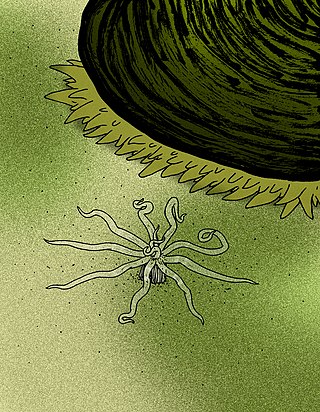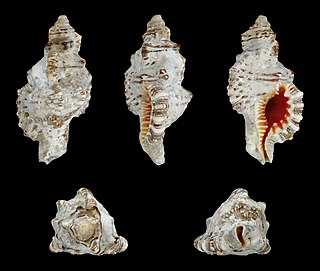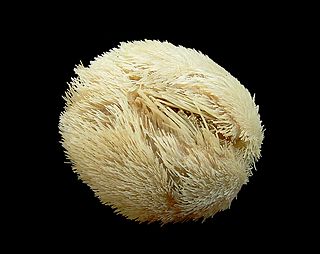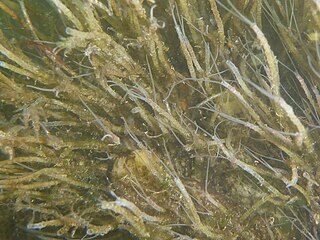
Clam is a common name for several kinds of bivalve mollusc. The word is often applied only to those that are edible and live as infauna, spending most of their lives halfway buried in the sand of the sea floor or riverbeds. Clams have two shells of equal size connected by two adductor muscles and have a powerful burrowing foot. They live in both freshwater and marine environments; in salt water they prefer to burrow down into the mud and the turbidity of the water required varies with species and location; the greatest diversity of these is in North America.

The Coral Sea is a marginal sea of the South Pacific off the northeast coast of Australia, and classified as an interim Australian bioregion. The Coral Sea extends 2,000 kilometres (1,200 mi) down the Australian northeast coast. Most of it is protected by the French Natural Park of the Coral Sea and the Australian Coral Sea Marine Park. The sea was the location for the Battle of the Coral Sea, a major confrontation during World War II between the navies of the Empire of Japan, and the United States and Australia.

Henri Milne-Edwards was a French zoologist.

Gwaii Haanas National Park Reserve, National Marine Conservation Area, and Haida Heritage Site, usually referred to simply as Gwaii Haanas, is located in southernmost Haida Gwaii, 130 kilometres off the mainland of British Columbia, Canada. Gwaii Haanas protects an archipelago of 138 islands, the largest being Moresby Island and the southernmost being Kunghit Island. "Gwaii Haanas" means "Islands of Beauty" in X̱aayda kíl, a southern dialect of the Haida language.

Cordell Bank National Marine Sanctuary is a marine sanctuary located off the coast of California. It protects an area of 1,286 sq mi (3,331 km2) of marine wildlife. The administrative center of the sanctuary is on an offshore granite outcrop 4.5 sq mi (12 km2) by 9.5 sq mi (25 km2), located on the continental shelf off of California. The outcrop is, at its closest, 6 mi (10 km) from the sanctuary itself.

A public aquarium or public water zoo is the aquatic counterpart of a zoo, which houses living aquatic animal and plant specimens for public viewing. Most public aquariums feature tanks larger than those kept by home aquarists, as well as smaller tanks.
Desmoscolecida is an order of marine nematodes. It has just one suborder, Desmoscolecina, which itself has one superfamily, Desmoscolecoidea. In a worm of this order, the body tapers towards each end and is marked by a number of well-defined ridges. Their number varies in the different species. The head bears four movable setae, and some of the ridges bear a pair either dorsally or ventrally. Two pigment spots between the fourth and fifth ridges are regarded as eyes. The Desmoscolecida move by looping their bodies like geometrid caterpillars or leeches, as well as by creeping on their setae. The mouth is terminal, and leads into a muscular oesophagus which opens into a straight intestine terminating in an anus, which is said to be dorsal in position. The sexes are distinct. The testis is single, and its duct opens into the intestine and is provided with two chitinous spicules. The ovary is also single, opening independently and anterior to the anus. The nervous system is as yet unknown.

Ivell's sea anemone is a species of sea anemone in the family Edwardsiidae. It is endemic to a single location, Widewater Lagoon in West Sussex, England, where it was first discovered by Richard Ivell.

Edwardsia is a genus of sea anemones, the type of the family Edwardsiidae. They have eight mesenteries and live in tubes in the sand. The name, in Neo-Latin, commemorates the French zoologist Henri Milne-Edwards.

Monoplex is a genus of predatory sea snails, marine gastropod mollusks in the family Cymatiidae.

Rissoa lilacina is a species of small sea snail, a marine gastropod mollusc or micromollusc in the family Rissoidae.

Echinocardium cordatum, also known as the common heart urchin or the sea potato, is a sea urchin in the family Loveniidae. It is found in sub-tidal regions in temperate seas throughout the world. It lives buried in the sandy sea floor.

Dyspanopeus sayi is a species of mud crab that is native to the Atlantic coast of North America. It has also become established outside its native range, living in Swansea Docks since 1960, the Mediterranean Sea since the 1970s, the North Sea since 2007 and the Black Sea since 2010. It can reach a carapace width of 20 mm (0.8 in), and has black tips to its unequal claws. It feeds on bivalves and barnacles, and is in turn eaten by predators including the Atlantic blue crab, Callinectes sapidus. Eggs are produced from spring to autumn, the offspring reach sexual maturity the following summer, and individuals can live for up to two years. The closest relative of D. sayi is D. texanus, which lives in the Gulf of Mexico; the two species differ in subtle features of the genitalia and the last pair of walking legs.

Edwardsiidae is a family of sea anemones. Edwardsiids have long thin bodies and live buried in sediments or in holes or crevices in rock.

Maude Jane Delap was a self-taught marine biologist, known for being the first person to breed jellyfish in captivity, and thus observed their full life cycle for the first time. She was also involved in extensive study of plankton from the coasts of Valentia Island.

Phyllochaetopterus is a genus of marine polychaete worms that live in tubes that they construct.
Edwardsia delapiae is a species of sea anemone which is currently only known from its type locality in South-West Ireland.
Edwardsia timida, also known as the timid burrowing anemone, is a species of sea anemone in the family Edwardsiidae.
Edwardsia claparedii is a species of sea anemone in the family Edwardsiidae.















